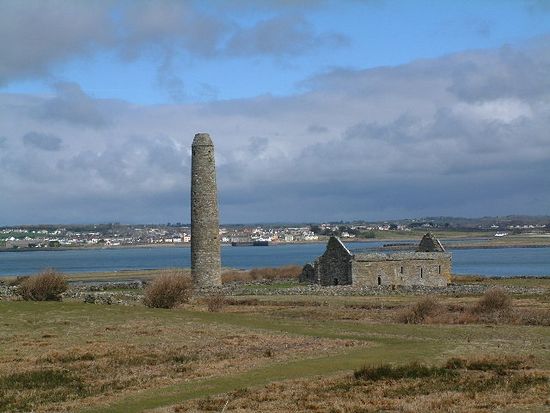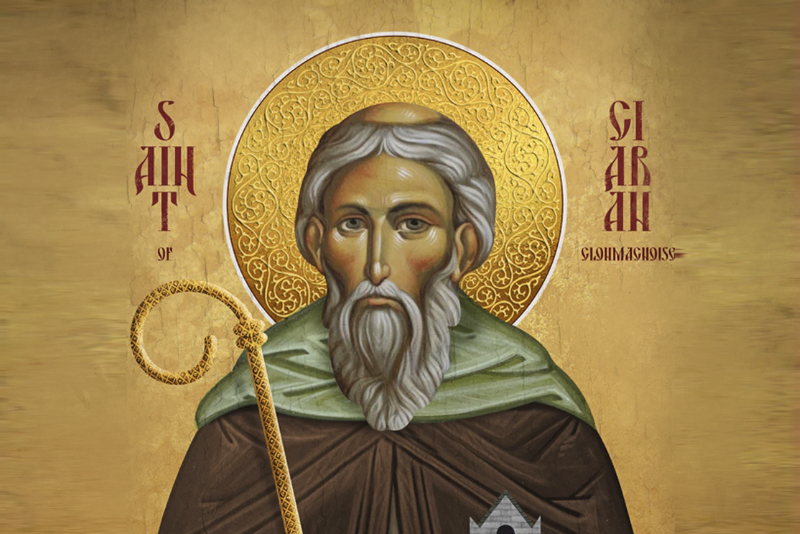
St. Ciaran (Kieran) of Clonmacnoise is known as “Ciaran the Younger”. He was born in about 512 (about 516 is also found) to the family of an itinerant carpenter and chariot-maker in the western Irish province (and former kingdom) of Connacht on the site of the present-day county of Roscommon. The saint’s birthplace was called Fuerty and his parents’ names Beoit and Darerca. Ciaran had brothers and sisters, some of whom also dedicated their lives to the service to God. The future abbot inherited from his ancestors a deep love for wisdom and learning. He was baptized by a righteous priest named Justus, who was his first instructor in the spiritual life. In his childhood the saint worked for some time as a cowherd, helping his family. His Life attributes his first miracles to that time when as a boy he already showed signs of holiness.
Ciaran was educated by the prominent theologian St. Finnian of Clonard, the spiritual father of the “Twelve Apostles of Ireland”. Here he showed himself to be a most gifted student and one of the most zealous monks. The Lord worked more miracles through his servant. After some time in Clonard he continued his studies with another great saint of the age—St. Enda of Inishmore, on one of three islands in western Ireland known as the Aran Islands. The future saint was to spend seven years in this island monastery and it was here that he was ordained priest. The tradition says that here a vision of a great miraculous tree once appeared before Ciaran. This tree was seen growing very high from the middle of Ireland, protecting the whole “Emerald Isle” (i.e. Ireland), with its sweet fruit surrounding the country, and beautiful birds taking some of the fruit to other lands. St. Enda realized that the miraculous tree was Ciaran himself, who was great in the eyes of God and man, and who would nurture and cover with his grace all Ireland, becoming a true mentor for many. Therefore St. Enda suggested that St. Ciaran go and found a monastery in central Ireland.

From there Ciaran then moved to Lough Ree (Lough is the Irish word for lake) where he settled on an island. There he lived the ascetic life for another seven years and built his first monastery. It is likely that at approximately the same time the ascetic also lived on Scattery Island, where his spiritual mentor was St. Senan, a great contemporary founder of Irish monasteries. The saint may have briefly visited other Irish islands, like Hare Island, where he also established small communities and worked miracles. (One of these stories is that once a monk lost the saint’s Gospel book in the lake, but in the summer when a cow went down to the water, a strap to the Gospel book stuck to one of the animal’s feet, and when the Gospel was lifted out onto the bank, all its pages and even letters appeared to be completely intact). His labours here prepared Ciaran to fulfil the main task of his life.
About the year 544 (or 548), Ciaran eventually established his main and greatest monastery of Clonmacnoise in the present-day county of Offaly in Ireland, on the west bank of the River Shannon. He predicted that many souls would go to heaven from this site, that the Lord would be especially present here forever and that many devout Christians would always visit this place. According to tradition, the saint was told to build this monastic complex at another, more beautiful site, but the saint declined, saying that all the beauties of our fleeting life should not divert monks from their striving for heavenly and spiritual heights. Ciaran became the first Abbot of Clonmacnoise and he formed for his brethren an ascetic rule which became known as “The Rule of St. Ciaran”. Soon afterwards more than half of all Irish monasteries began to follow this very strict ascetic rule. First of all, the saint confirmed his preaching with his own example, for he was generally known as a man of faith, prayer, fasting, labour, humility, learning and discipline, as well as protector of the poor. It was recorded that Diarmait, the future high king of Ireland, much assisted Ciaran in founding the monastery and promised to endow lands for its needs.
You can order an icon of any saint in our icon-painting studio
Source: orthochristian.com




